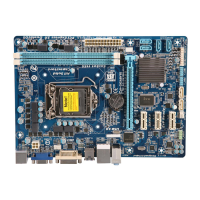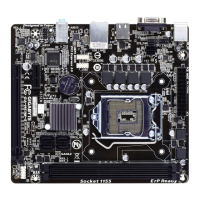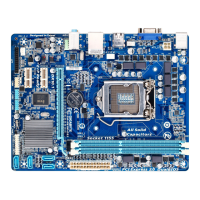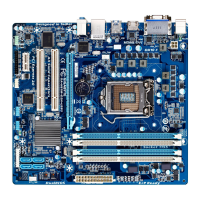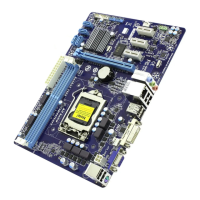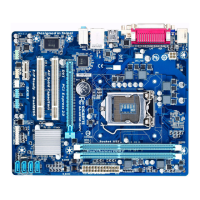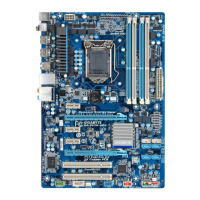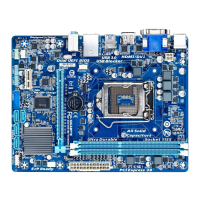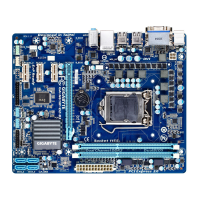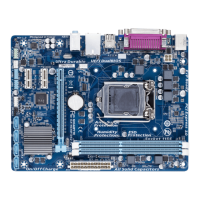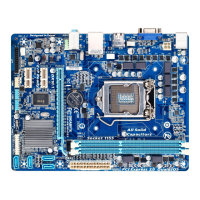Do you have a question about the Gigabyte GA-H61MA-D2V and is the answer not in the manual?
Lists the items included in the motherboard package.
Guidelines to prevent damage from electrostatic discharge and improper handling.
Guidance on inserting expansion cards into PCI Express slots.
Details about SATA 3Gb/s connectors for storage devices.
Configuration and usage of USB 2.0/1.1 headers.
Information on the CMOS battery and its function.
Displays the initial screen shown when the computer boots.
Allows adjustment of the CPU clock ratio for performance tuning.
Displays the current operating CPU frequency.
Configure advanced CPU core settings like Turbo Boost and core control.
Controls CPU PLL voltage for higher values or default settings.
Allows real-time CPU clock ratio changes within the operating system.
Enables or disables Intel CPU Turbo Boost technology for increased performance.
Sets CPU Turbo ratios based on the number of active cores.
Sets a power limit for CPU Turbo mode to manage consumption.
Sets a current limit for CPU Turbo mode to manage consumption.
Determines the number of CPU cores to enable for operation.
Enables or disables Hyper-Threading technology for multi-processor support.
Enables or disables CPU power-saving function in system halt state.
Allows CPU to enter C3/C6 mode in system halt state for power saving.
Enables or disables CPU thermal monitor for overheating protection.
Enables or disables Enhanced Intel SpeedStep Technology for power saving.
Manages PROCHOT signals for CPU performance reduction during overheating.
Sets the system memory multiplier for performance tuning.
Displays the system's memory operating frequency.
Allows system operation at different performance levels (Normal, Turbo, Extreme).
Selects DRAM timing configuration (Auto, Quick, Expert).
Displays the configured DDR memory voltage.
Displays the VTT voltage, dependent on the installed CPU.
Enables or disables memory channel interleaving for performance.
Enables or disables memory rank interleaving for performance.
Allows setting the CPU Vtt voltage.
Allows setting the memory voltage.
Manages the record of previous chassis intrusion status.
Displays the detection status of the chassis intrusion detection device.
Displays the current system voltages.
Displays current CPU/system temperature.
Displays current CPU/system fan speeds.
Sets warning threshold for CPU temperature.
Alerts if CPU or system fan is not connected or fails.
Controls CPU fan speed based on temperature or manual settings.
Controls system fan speed based on temperature or manual settings.
Enables specific streams within CPU and Chipset for data transfer.
Selects the default language used by the BIOS.
Sets the system date.
Sets the system time.
Displays current access level based on password protection.
Provides information on devices connected to SATA ports.
Specifies the overall boot order from the available devices.
Specifies the boot order for specific device types.
Enables or disables Numlock on the numeric keypad after POST.
Determines whether to display the GIGABYTE Logo at system startup.
Determines which Option ROM to launch (Legacy or EFI).
Limits CPUID maximum value for OS compatibility.
Enables or disables Intel Execute Disable Bit function for security.
Enables or disables Intel Virtualization Technology for running multiple OS.
Enables or disables Intel Virtualization Technology for Directed I/O.
Configures an administrator password for BIOS access.
Configures a user password for limited BIOS access.
Activates boot ROM integrated with the onboard LAN chip.
Enables or disables the integrated SATA controllers.
Configures SATA controllers to IDE or AHCI mode.
Enables or disables the integrated USB 2.0 controllers.
Enables or disables the onboard audio function.
Specifies the primary display initiation (PCIe or onboard graphics).
Enables or disables the onboard graphics function.
Sets the onboard graphics memory size.
Allocates DVMT memory size for onboard graphics.
Allows USB keyboard/mouse usage in MS-DOS.
Enables or disables Etron EJ168 USB 3.0 controllers.
Enables XHCI Hand-off for OS without XHCI support.
Enables EHCI Hand-off for OS without EHCI support.
Emulates I/O ports for legacy USB keyboard/mouse support.
Configures connected USB mass storage devices.
Determines system state after AC power loss.
Allows turning on the system via PS/2 keyboard wake-up.
Specifies the ACPI sleep state when the system enters suspend.
Sets a desired time for the system to power on automatically.
Sets system to consume less than 1W power in S5 state.
Enables or disables High Precision Event Timer for OS.
Configures turning off the computer using the power button.
Allows onboard graphics to enter standby mode to decrease power.
Allows onboard graphics to enter deeper standby mode.
Saves changes to CMOS and exits the BIOS Setup program.
Exits BIOS Setup without saving changes made to CMOS.
Loads optimal BIOS default settings for system operation.
Selects a device to boot immediately.
Saves current BIOS settings to a profile.
Loads BIOS settings from a previously created profile.
| Non-ECC | Yes |
|---|---|
| Memory voltage | 1.5 V |
| Memory channels | Dual-channel |
| Memory slots type | DIMM |
| Number of memory slots | 2 |
| Supported memory types | DDR3-SDRAM |
| Maximum internal memory | 16 GB |
| Supported memory clock speeds | 800, 1066, 1333 MHz |
| Supported memory module capacities | 1GB, 2GB, 4GB, 8GB |
| Processor socket | LGA 1155 (Socket H2) |
| Processor manufacturer | Intel |
| Compatible processor series | Intel Celeron, Intel Pentium |
| Maximum number of SMP processors | 1 |
| Number of SATA II connectors | 4 |
| USB 3.2 Gen 1 (3.1 Gen 1) connectors | 0 |
| USB 2.0 ports quantity | USB 2.0 ports have a data transmission speed of 480 Mbps, and are backwards compatible with USB 1.1 ports. You can connect all kinds of peripheral devices to them. |
| Component for | PC |
| Power source type | ATX |
| Motherboard chipset | Intel® H61 |
| Audio output channels | 7.1 channels |
| Motherboard form factor | micro ATX |
| Windows operating systems supported | Windows 7 Home Basic, Windows 7 Home Basic x64, Windows 7 Home Premium, Windows 7 Home Premium x64, Windows 7 Professional, Windows 7 Professional x64, Windows 7 Starter, Windows 7 Starter x64, Windows 7 Ultimate, Windows 7 Ultimate x64, Windows Vista Business x64, Windows Vista Enterprise, Windows Vista Enterprise x64, Windows Vista Home Basic, Windows Vista Home Basic x64, Windows Vista Home Premium, Windows Vista Home Premium x64, Windows Vista Ultimate, Windows Vista Ultimate x64, Windows XP Home, Windows XP Home x64, Windows XP Professional, Windows XP Professional x64 |
| Supported storage drive interfaces | SATA II |
| Maximum resolution | 1920 x 1200 pixels |
| Parallel processing technology support | Not supported |
| Controller interface type | iTE IT8728 |
| PCI Express x1 slots | 3 |
| LAN controller | Realtek RTL8111E, Realtek RTL8111F |
| Ethernet interface type | Gigabit Ethernet |
| BIOS type | EFI AMI |
| ACPI version | 2.0a |
| BIOS memory size | 64 Mbit |
| Depth | 174 mm |
|---|---|
| Width | 244 mm |
